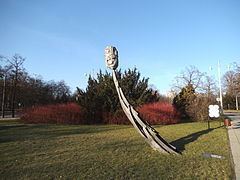Discovered by E. Bowell MPC designation 12999 Toruń Orbits Sun Asteroid group Asteroid belt | Discovery date 30 August 1981 Named after Toruń (Polish city) Discovered 30 August 1981 Discoverer Edward L. G. Bowell | |
 | ||
Alternative names 1981 QJ2 · 1957 TF1998 QL8 People also search for 2648 Owa, Sun, 298 Baptistina, 1696 Nurmela, 2093 Genichesk | ||
12999 Toruń, provisional designation 1981 QJ2, is a carbonaceous Baptistina asteroid from the inner regions of the asteroid belt, approximately 8 kilometers in diameter. It was discovered on 30 August 1981, by British–American astronomer Edward Bowell at Lowell Observatory's Anderson Mesa Station in Flagstaff, Arizona.
The C-type asteroid belongs to the small Baptistina family. It orbits the Sun at a distance of 1.8–2.7 AU once every 3 years and 5 months (1,252 days). Its orbit has an eccentricity of 0.19 and an inclination of 6° with respect to the ecliptic. The first precovery was taken at Goethe Link Observatory in 1957, extending the asteroid's observation arc by 24 years prior to its discovery.
A rotational light-curve was obtained from photometric observations at the U.S. Palomar Transient Factory in December 2009. The provisional light-curve gave a rotation period of 7000355210000000000♠3.5521±0.0026 hours with a brightness amplitude of 0.09 in magnitude (U=1).
According to the survey carried out by the NEOWISE mission of NASA's Wide-field Infrared Survey Explorer, the asteroid measures 3.5 kilometers in diameter and its surface has a very high albedo of 0.39. The Collaborative Asteroid Lightcurve Link (CALL) disagrees with the findings by the space-based mission and assumes a standard albedo for carbonaceous asteroids of 0.057, with a correspondingly larger diameter of 8.0 kilometers. As with 1696 Nurmela, another member of the Baptistina family, CALL assumes this asteroid's composition (also see carbonaceous chondrites) to differ significantly from the much brighter asteroid 298 Baptistina, which is considered to be an interloper in its own family.
In 2008, the minor planet was named after the city of Toruń, Poland. It is the birthplace of Nicolaus Copernicus, significant to Polish and European history, a UNESCO World Heritage listed Old Town, and the main site of the Nicolaus Copernicus University, where its observatory at Piwnice, the largest in Poland, is located. The naming followed a suggestion by Polish astronomer T. Michałowski. Naming citation was published 21 March 2008 (M.P.C. 62354).
